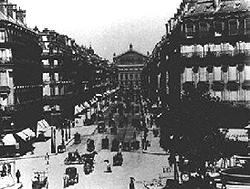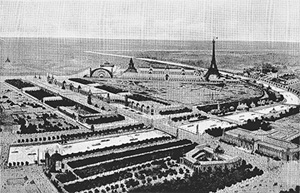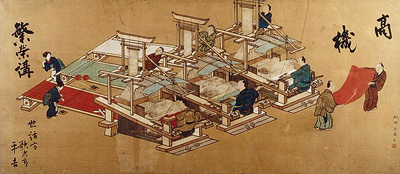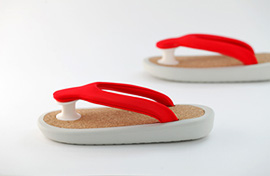
In 1875 (Meiji era year 8), our history began when Jubeimon started timber and textile businesses, and he made geta sandals using leftover materials.
When the Edo era governed by the Tokugawa shogunate came to an end, and in the midst of chaos of transformation into a modern nation, which included banning mens’ topknot hairstyles (chonmage) and samurai swords, most of Japanese wore kimonos and women put their hair up in the Japanese style.
At this time, Napoleon III drove a revolution for The City of Lights, Paris, and completed the Palais Garnier opera house in the same year.

As a symbol of the new era, the fifth International Exposition was held in Paris (The first prize went to an American inventor Charles Seeberger who introduced his trademarked “escalator”).
Bushido by Inazo Nitobe and The Book of Tea (1906) by Tenshin Okakura introduced not only Japanese paintings and artwork but also our spiritual nature to the world.
Nishijin is a leading brocade producing city that was expanded after the Onin War (1467 to 1477) and the “Nishijin” brand was built under the protection of the government in 1548.
Nishijin brocade reached full bloom in the beginning of the 18th century with overwhelming support from rich merchants and artisans. Then with the promotion of modernization, they created unique Jacquard weave and now Nishijin is still one of the best Japanese brocades. In this city, we continue our study and education.
Salvador Dali, Pablo Picasso, Henri Matisse, Alberto Giacometti, Jean Genet, and Henri Michaux... When Paris made the stage for many artists, writers, and poets, Naito moved the present office into Gion where they had a branch office. Gion is among the most famous entertainment district of Japan that continues to have many maiko, or apprentice geisha and geisha from the Meiji era and still retains its gorgeousness and class. Starting our business in a watershed of Japanese culture, we have pursued and served beauty derived from functionality that is unique to Kyoto to support good old practices, strive for beauty in ordinary life, and superimpose them.

Japanese footwear has such traits as minimum and perfect shape as a tool, a variety of colorful and rare materials on a global basis, and to implicitly express the day’s purpose, tone, and situation.
Customarily, we take off our shoes. This is characteristic of Japanese culture. The origins of our life come from a worldview to coexist with nature, and where the border between in and out is ambiguous.
After carrying their master to the destination front door, footwear is arranged nicely and represents people’s awe and thankfulness in peace.
Gion Naito appreciates beauty coming from spirit and continues to support footwear in the roots of Japanese culture.
Our late fourth Naito owner regarded “footwear as a vase to give flowers life” and said “Feet are roots to grow buds, so take good care of them”.
Our products are all handmade by artisans. We measure every customer’s feet and understand their physical features. And we create footwear that has a reputation as “intoxicates from the soles of the feet” through conversations with customers.
Footwear is a tool and a decoration. Naito has a spirit to create things understanding each user’s situation as brocade craftsmen.

Serving top quality Japanese style footwear, our customers include kabuki actors, famous actresses, writers, intellectuals and our products have appeared in many well-known magazines, TV and radio programs in Japan.
To bring our many years of well-rounded knowledge to the world, we set up The Mana Project in 2012. In this project, we aim to produce stories (goods) by presenting materials, techniques, and methods to help our life and build a bridge to the future. The first project is the footwear “JoJo”.
Mana means spirituality and vitality in all people in Hawaii. In Melanesia, it means the origin of mystical power.
In Indo-European culture, Mana suggests foods given by the sky. And also means mind, moon, and Magna Mater in women, and blood of wisdom.
Magna Mater is a goddess who brings fertility and productiveness and thoroughly represents earth. The Japanese famous guardian deity is Toyokebime that blesses clothing, food, and housing.
Geta is a Japanese traditional footwear that looks like clogs or sandals. It has a raised wooden sole and holds the foot with a cloth strap. Now many people wear geta with Japanese kimonos and yukata or summer kimonos. In the past, mainly monks and Shinto priests wore them.
Zori is also a Japanese traditional footwear that consists of a sole and a strap. Mainly they are worn with Japanese traditional clothes, but these days many people wear zori with European clothes, too.
These days, we see geta with casual summer kimonos, and Zori with rather formal kimonos. But in days of old, zori meant a footwear for dressing and was worn inside houses, and geta meant wooden clogs to wear outside. On the streets, only people who serve to gods and Buddha, and people of high status could wear geta. Normal people wore straw sandals but now they are used for special occasions like traditional festivals and zori and straw sandals are seen as practically the same.
These days children are encouraged to wear geta or zori with the belief that footwear with straps strengthen feet. The foot muscles can be strengthened by grabbing a strap and holding onto a sole and that helps developing the arch of the foot and preventing bunions.
With oriental medicine, acupressure points between fingers are important to vitalize the flow of all over body’s life force, or qi.
Balancing on the big toes and placing the center of gravity on the lower abdomen are basic features for Japanese classical dance, martial arts, and other actions. Sophisticated Japanese action has secrets in usages of the base of the foot‘s toes.
The shape of the foot shows a unique episode.
The hooves of huge cows and muscular horses have characteristics on their own to show the importance of bases of toes. Cows with cloven hooves can turn around on the spot, but horses with whole hooves need to make a big U-turn to change directions. A small difference in shape makes a big impact on movement.